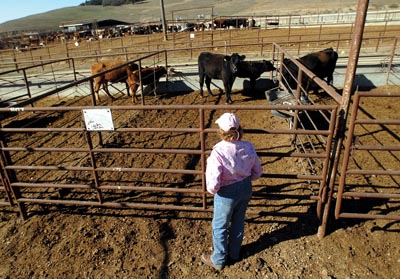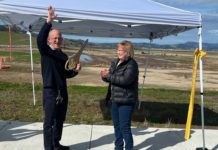
By Colin McConville and the Associated Press
HOLLISTER
California’s worst drought in decades is forcing some San Benito County and other California cattle ranchers to downsize their herds because two years of poor rainfall have ravaged millions of acres of rangeland used to feed cows and calves.
Jim Warren, rancher and owner of 101 Livestock Market in Aromas, said that “every ranch is different.” He added that some ranchers have water but are low on feed and some have feed but are low on water.
Warren said that forage, or grass supply, is the most important issue facing cattlemen these days. With lack of water, he said, “You have to buy hay and it gets expensive.” Rather than buy that hay, some are forced to liquidate their inventory.
During most dry years, California cattlemen send their herds to places with healthier pastures or buy supplemental feed to sustain their animals until the rainy season. But high fuel prices, a lack of green pastures in California and neighboring states, and the soaring cost of livestock feed have left ranchers little choice but to sell off their mother cows because they can ill afford to feed them.
California ranchers typically raise calves for six to 10 months before selling them to feedlots in Texas, Nebraska, Colorado and other states, but they usually keep mother cows that produce offspring for a decade.
“Cattle producers in the state are facing some serious management decisions,” said Matt Byrne, executive vice president of the California Cattlemen’s Association. “When you’re counting on something from Mother Nature, it’s always a risky business.”
The number of beef cows on California pastures dropped from 700,000 in January 2007 to 655,000 in January 2008, or 6 percent, according to the U.S. Department of Food and Agriculture. John Nalivka, president the agricultural research firm Sterling Marketing, expects another 6 percent decline when new cattle numbers are reported in January.
The parched, yellow pastures on Joe Gonzales’ cattle ranch attest to the severity of a dry spell that is hurting the economic fortunes of many of the state’s beef producers.
Gonzales, who normally runs 500 cows on his 2,000-acre spread near Gilroy, cut his herd by half over the past year and may have to sell more if the drought persists.
“When there’s no rain, there’s no grass,” said Gonzales, 65. “It’s the worst I’ve seen it in more than 30 years.”
San Benito County Cattlemen’s Association treasurer Jeanie Coefield said ranchers used to hold onto smaller cattle in a situation like this. To save money, she said, “Anything that’s not producing has to be sent down the road to be butchered.”
National Weather Service representative and Hollister resident Mark Strobin said that the last two years have been “extremely dry.” From numbers measured at the Fairview Road Calfire Station, this fall also has been unfavorable. For the month of October, Hollister received 0.18 inches of rain with the average being 0.63 inches. September was even drier with no recorded rainfall.
Annually, an average of 14.01 inches of rain falls on Hollister, according to Strobin. From last year’s measurements, which run from July through June, Hollister received 10.63 inches. That is about 75 percent of the normal amount of rain for the year. For 2006-07, the area had 7.15 inches, or 51 percent of the usual annual rainfall.
Local cattlemen, however, appear optimistic about this winter bringing more rain.
“Anyone in the cattle business is optimistic. That being said, I think there’ll be more rain.”
The drought has also hurt out-of-state ranchers who normally bring their cattle to graze on California pastures during the winter rainy season. Some of those cattlemen are selling their cows because feeding them is too costly, said Nalivka from Sterling Marketing.
California, the fourth-largest U.S. beef cattle producer, is downsizing at a time when U.S. beef production is shrinking amid higher fuel and feed prices. The herd reductions will likely mean price increases for consumers.
Gov. Arnold Schwarzenegger declared a statewide drought in May after the state recorded two years of below-average rainfall, a sharp reduction in Sierra Nevada snowpack and its driest spring on record. Late last month, state water officials warned local agencies that their water deliveries could be cut by as much as 85 percent next year.
The only true measure of rainfall will be when winter ends, said Joe Morris of TO Cattle Co. in San Juan Bautista. He has heard both sides of the prediction spectrum for rainfall. In either case, he will prepare for any rain and said, “I’ll tell you in June.”









